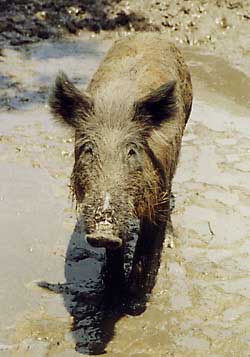Black bear damage to the honey industry is a significant concern. Damage to apiaries in the Peace River area of Alberta was estimated at $200,000 in 1976. Damage incidents in Yosemite National Park were estimated to be as high as $113,197 in 1975, with $96,594 resulting from damage to vehicles in which food was stored. Thirty percent of all trees over 6 inches (15 cm) tall were reported to be damaged by black bears on a 3,360 acre (1,630 ha) parcel in Washington State. In Wisconsin, one female black bear and her cubs caused an estimated $35,000 of damage to apple trees during a two-day period in 1987. In general, black bears can inflict significant economic damage in localized areas.Some states pay for damage caused by black bears. In western states, losses caused by black bears are usually less than 10% of total predation losses, although records are not complete. The extent of claims paid are not high but usually are greater than the license income that state wildlife agencies receive from black bear hunters. Deems and Pursley (1983) listed the states and provinces that pay for black bear depredations.
Feral Hog Biology and Behavior
Feral pigs are very intelligent animals and readily adapt to changing conditions. These wild pigs may modify their response to humans fairly rapidly if it benefits their survival. Wild boar (introduced from Europe) have a greater capacity to invade colder and more mountainous terrain than do other feral pigs. Feral hogs feed during daylight hours or at night, but if hunting pressure becomes too great during the day, they will remain in heavy cover at that time and feed at night. In periods of hot weather, wild pigs remain in the shade in wallows during the day and feed at night. Continue reading Feral Hog Biology and Behavior
Locating Coyote Dens
Predation can frequently be resolved by locating coyote dens and removing the pups and/or the adults responsible for depredations. Denning may also be warranted as a preventive control strategy if coyote predation has historically and consistently occurred in a particular area during the lambing season. Continue reading Locating Coyote Dens
Legal Status of Bobcat
Among midwestern states, the bobcat is protected in Iowa, Illinois, Indiana, Ohio, and in most counties of Kentucky. It is managed as a furbearer or game animal in the plains states. Western states generally exempt depredating bobcats from protected status. They can usually be killed by landowners or their agent. In the more eastern states and states where bobcats are totally protected, permits are required from the state wildlife agency to destroy bobcats. Consult with your state wildlife agency regarding local regulations and restrictions.Â
Trapping Grizzly Bear
The capture and translocation of bears can be effective in damage control. Unfortunately, relocation often only moves the problem to another site, and bears have been known to travel great distances to return to a trapping site. The handling process, if done correctly, is itself sufficiently traumatic to teach the bears to avoid humans. Use culvert traps or foot snares to capture bears. Continue reading Trapping Grizzly Bear
Identifying Grizzly Bear Sign and Damage
Brown (grizzly)Â bears have many unique behaviors that subject them to situations in which they are perceived as a threat to humans or personal property. They are opportunistic feeders that may switch to scavenging human-produced food and garbage if made available, becoming a problem around parks, camp grounds, cottages, suburban areas, and garbage dumps. Bears that are conditioned to human foods become used to the presence of humans and are therefore the most dangerous. Continue reading Identifying Grizzly Bear Sign and Damage
Idenifying Badger Sign
Most damage caused by badgers results from their digging in pursuit of prey. Open burrows create a hazard to livestock and horseback riders. Badger diggings in crop fields may slow harvesting or cause damage to machinery. Digging can also damage earthen dams or dikes and irrigation canals, resulting in flooding and the loss of irrigation water. Diggings on the shoulders of roads can lead to erosion and the collapse of road surfaces. In late summer and fall, watch for signs of digging that indicate that young badgers have moved into the area. Continue reading Idenifying Badger Sign
